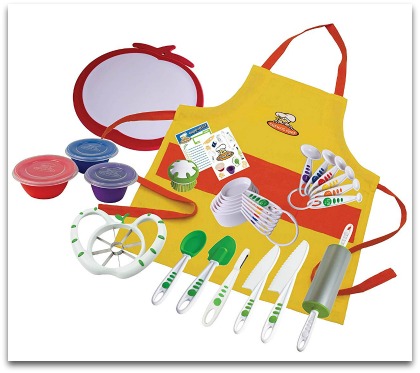 Oh, the things we believe before we have children!
Oh, the things we believe before we have children!
My kids won’t be picky eaters.
They won’t live off fruit snacks and goldfish crackers.
My kids will joyfully eat everything I give them, and I’ll only give them healthy, organic, free-range, no additive, locally grown foods from BPA-free containers.
That soooo did not happen for me.
I tried to do all the right things and follow all the advice. I ate a wide variety of food when I was pregnant and nursing, so my baby would experience the flavor of different foods. I made homemade baby food, often using fruits and vegetables that I’d never tried before just to develop their palate.
It was fun and easy. Everything was going great. I had two babies who happily ate everything for the first year and a half.
Then, they became toddlers (I’m pretty sure a lot of horror stories begin that way). When my son started pushing, or rather, throwing, food off his plate, I realized I needed to get creative if I was going to continue feeding him healthy meals.
I was surprised by how quickly my son’s preferences changed. However, experts are not. In the journal, Frontiers in Pediatrics, Dr. Jason Lam reminds us that, “Picky eating is a relatively common behavioral problem that most children will eventually outgrow. Its roots stem from both environmental and genetic influences.”
Knowing it was a stage, like all others that arise in parenting, encouraged me to persevere and not take it personally. I didn’t fail as a parent… I just had to come up with a new plan.
Dr. Lam advises, “Repeated exposure to new food in a non-coercive manner and in an environment that is both fun and rewarding may help overcome picky eating. Patience, time, and repetition may be the keys to success.”
After experimenting with my first son, I was more prepared once my younger son started rejecting foods, though I still had to modify some of my strategies. I also found I had to continue being creative to keep my older son interested in a variety of foods and not stuck in a beige colored food rut.
For our family, these 6 tricks, some of them a bit off-the-wall, worked best –
Mix It In
 When my toddler first started refusing a dish, I would mix in applesauce, mashed bananas, or yogurt.
When my toddler first started refusing a dish, I would mix in applesauce, mashed bananas, or yogurt.
I literally mixed it into everything. “You don’t want lasagna? Look, there’s applesauce on it!” “You don’t want to try the salmon patty? Let’s dip it in yogurt!”
Disgusting, right? But it worked!
You could also try ketchup, ranch dressing, hummus, or barbeque sauce and you might be surprised by what your child is willing to eat.
Older children may be interested in a smoothie version of this. A fruit smoothie with a handful of spinach blended in may be more palatable than a side of steamed spinach. There are lots of delicious smoothie combinations that hide the taste of vegetables while also introducing new fruits.
Dinner for Breakfast
As babies and toddlers, my children were always the most hungry and receptive to new foods in the morning, so I often fed them left-overs from dinner for breakfast.
They didn’t think it was odd as they eagerly ate vegetable lasagna or pot roast at 8am and I felt relief knowing they already had one well-balanced meal for the day. As this mom writes, I’m not the only one doing this.
Last night’s dinner may not sound appetizing to your school-aged kids as you coax them out of bed in the morning, but offering their favorite healthy dish for breakfast like soup, pasta, or a sandwich may be a fun surprise they may be more open to than you would guess.
Allow Entertainment
I’m sure this is controversial, and understandably so, but I let my kids bring books and toys to the table while they eat. We make it fun and interactive.
If I’m reading a book to them they must take a bite before I turn the page. If they want to assemble a puzzle I hold all the pieces and they get a piece of the puzzle for every bite of food.
You could build with Legos, or play cards, or incorporate whatever your child is interested in.
Yes, distracted eating is another issue to be addressed (research shows it can lead to overeating, especially for older kids or adults), but in my mind, and for my children at that this age, eating a healthy meal is much more important than proving my kids to be proper and mindful.
I also try to limit distracted eating to meals that I know they will be the least enthusiastic about, which in our household tend to be the most nutritious. I can’t win all battles at once, but I’m going to do what I can to win the battle for healthy food.
Involve Your Child in the Process
A huge help in making my children more adventurous eaters was to include them in the shopping and cooking.
I’d let them pick out fruits and vegetables from the grocery store, encouraging them to find something new. They often went for the oddest-looking produce, but they felt empowered to try it because they had picked it out.
 I’d also let them help prep meals. I initially bought one of those chef kits which had high quality, kid-safe cooking utensils, and my boys loved it.
I’d also let them help prep meals. I initially bought one of those chef kits which had high quality, kid-safe cooking utensils, and my boys loved it.
As they peeled and cut vegetables, they were often willing to take a bite of it. The first time I let my younger son help prep dinner, I gave him an onion without much thought. It was a rough introduction, but despite the onion tears he still enjoyed it and wanted to cut more.
Older kids can even find new recipes to try, spice up a family recipe, or develop their own. You could go even further and work together to plant a garden. There’s a lot of great learning potential and quality time opportunities intertwined in this one!
A 2014 study compared the eating behavior of children ages 6-10 years old who cooked lunch with a parent versus children who were not involved in the preparation. The findings showed that children who helped cook ate 76% more salad and 27% more chicken than those who were simply served the meal!
It may take more time and patience to involve your children in meal preparation, but the results are worth it, not to mention the valuable life skill you’re teaching in the process.
They Can’t Eat it if You Don’t Offer it to Them!
 When I served our meals, I kept assuming that my sons wouldn’t eat the broccoli, or the tomatoes, or the salmon, so I didn’t put it on their plate.
When I served our meals, I kept assuming that my sons wouldn’t eat the broccoli, or the tomatoes, or the salmon, so I didn’t put it on their plate.
I finally had a revelation one day. How could I expect them to eat it if I’m not even giving them the chance to see it?
Vegetables were our biggest challenge, so I started placing a vegetable on their plate. I started with just one small broccoli floret or one cucumber slice, and encouraged them to take “one polite bite” before they got up from the table.
If they wanted a piece of chocolate or candy or anything else after dinner then they needed to eat another piece. Eventually we could increase the amount of vegetables.
Sometimes I would put two different types of vegetables out and they would beg to eat one over the other.
“Ok, you can eat 6 cucumbers or 3 cauliflowers.”
“Fine, six cucumbers!”
Wait? That worked?
You may hear more complaining and whining when you start putting things you know they hate on their plate, but you must give them the chance to prove you wrong! Be creative and fun and start small. “You don’t have to eat the tomato, just lick it.”
They’ll probably be so amused by this request that they’ll actually do it, and then you’re one step closer!
Change the Preparation
 I have a friend whose children are always snacking on raw vegetables. Initially I was just impressed that they ate vegetables so readily, but eventually I realized that I rarely offer my kids raw vegetables. I’ll steam and roast and puree and sauté all day, but I never hand my kids a stick of celery.
I have a friend whose children are always snacking on raw vegetables. Initially I was just impressed that they ate vegetables so readily, but eventually I realized that I rarely offer my kids raw vegetables. I’ll steam and roast and puree and sauté all day, but I never hand my kids a stick of celery.
Once I introduced raw vegetables as an alternative to whatever cooked vegetables we were having I found they almost always preferred raw.
Now, I usually put a bowl of raw vegetables on the table with dinner and often they’ll plead to eat those instead of something else that’s on their plate. “Sure, you can eat carrots instead of rice!”
Older kids are almost always hungry. Having a veggie tray on the table right before dinner or a bowl of cut fruit ready when they come home from school is a great way to allow them to curb their outrageous hunger. And it still gives them something nutritious for their bodies.
Your children may prefer roasted vegetables to raw, shredded chicken to cubed, or frozen blueberries to fresh. Play with different preparations, shapes, and textures, and you may be surprised!
There is a plethora of ideas in addition to these to encourage your picky eater, but repetition is the essential theme. The more your child sees and tastes a food the more likely they’ll (eventually) willingly eat it. So stay patient and continue to make healthy food accessible.
Of course, if you feel nothing is working or you have serious concerns about your child’s nutrition, it may be worth a visit to your pediatrician.
2-Minute Action Plan for Fine Parents
What do your kids like to eat? What new foods can you serve with it?
Which kinds of foods will your child absolutely not eat. Why do you think that is? Think of a technique (maybe served raw? maybe with a dip?) that might help your child become more receptive and begin to offer that food group once a day.
Think about what your child’s reaction will be so you’re prepared to respond. What small compromises are you able to make so she becomes more familiar with and willing to eat new food?
Long-Term Action Plan for Fine Parents
Think about what may contribute to your child’s lack of desire to try new foods. Are they not hungry enough? Maybe you need to evaluate what else they’re consuming during the day and at what times. Are they observing other children or adults that refuse to eat certain foods?
Pick one or two techniques each week and see how your child responds. Consider which positive reinforcements could motivate him.
Find a time to take them to the grocery store so you can all experiment with some new veggies. Ask them to help you prepare them for the rest of the family!
Incorporate books, television, friends, or games that reinforce the concept of trying new foods or healthy eating. Be encouraging and supportive while continually offering a variety of food.
Great article! Thank you so much for sharing your experience! I’m sure most people can take notes from this article. One thing most people lack the experience to encourage baby for feeding regularly. Well, this post gives us some good ideas for choosing baby food. Thanks.
OMG! Thanks a lot Kristin for sharing such an informative page about Encourage Picky Eaters to Eat. I have read your valuable page and gotten much information. I have learned a lot from you that I did not know before. I confused for choosing the Baby Foods information what would be the best for everything but now my confusion has cleared by your review. Keep it up………..
Hi Kristin, I don’t know of any toddler who hasn’t been through the ‘beige stage’ and yep, they can take a looong time to eat (even foods they love!) and applause to every parent who gets dinner on the table with a couple of toddlers at your feet.
While I like reading other parent’s hacks and tips, I’m wary that some of your suggestions can set our kids up for an unhealthy relationship with food and eating.
My approach is that it’s our job as parents is to offer up plenty of nutritious foods and the kid’s job is to eat what they need to.
Some days that’s A LOT! Other days it seems like barely anything. As long as there’s plenty of water available and you keep offering opportunities to eat, they will be fine. No need to stress about what they eat at one meal, or even over one day.
We choose not to get into power struggles over food and that includes not negotiating treats or bribes (including attention, sweets, entertainment or the promise of dessert) for bites of ‘healthy’ food. If one of the kids aren’t that interested in that meal, that’s okay. So long as they sit at the table with the rest of the family for dinner, they are welcome to decide what they want to eat off their plates. Of course they’re encouraged to try everything and praised for tasting things, but not for the actual act of eating and definitely not for finishing their plate.
I feel like the mix it in strategy could be really useful… but not when using a high sugar and salt topping like sauce or dressing. Not only unhealthy but locks kids palates into a particular taste profile. Mixing new foods in with old favourites can work well (spinach and fruit smoothie icypoles are very popular in our house!).
Getting kids involved is definitely a winner. Tonight the 2.5yo chopped mushrooms alongside me (1yo gets some pots and utensils to bang on at my feet) and they often eat a heap of veggies while we’re getting dinner ready. He is really proud to tell everyone dinner is ready and we make a point to say how delicious the mushrooms he chopped, or the eggs he whisked are.
It can be frustrating when kids take ages to eat, so we try to allow plenty of time, or leave out a lunchbox for daytime grazing between playing. When early morning car rides are needed we sometimes pack breakfast on the go like squeezy pouch of yoghurt, a banana and a croissant or scroll each. Another tip someone shared with me for younger kids is to have two spoons or forks at the table so you can load up one while they’re eating from the other.
We’re definitely not health freaks but we do use real food and we don’t keep stuff in the house that we don’t want to eat. No amount of pestering will produce what you don’t have. We do enjoy a treat but tend to sit down to enjoy it together for morning tea, rather than it being linked to dinner (this allows plenty of time for a sugar rush to be burned off playing too).
Most adults get into a bit of a culinary rut so having little people to feed can be a great opportunity for the whole family to try new foods, or new ways of eating the usual stuff, good luck to all the parents out there.
Thanks for your comment, Bel! You make some great points and good suggestions. I love learning what strategies other parents use!